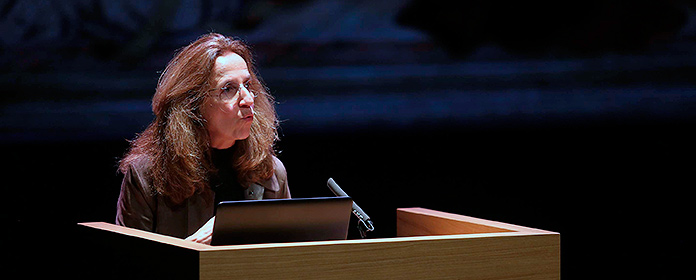2020_01_09_FYL_noticia_alicia_rodes
About 150 people participate in the lecture series that the Prado Museum organizes with the School of Philosophy and Letters
Alicia Rodés, art historian, gave the first session on the representation that the Annunciation has had throughout history.

"The Annunciation is present in the history of art from the birth of Christianity until today. Depending on the circumstances we have lived through throughout history, we have positioned ourselves in one way or another before this dialogue, but the story has always been the same". This was stated by Alicia Rodés, art historian, at the University of Navarra in the lecture series that the School of Philosophy and Letters of the academic center organizes in partnership with the Friends of the Prado Museum Foundation. From this year, the cycle has been renamed "Francisco Calvo Serraller", in memory and tribute to its organizer, Professor Francisco Calvo Serraller, who died in November 2018.
quotation Nearly 150 people attended yesterday the first session of this series, which will deal with the stories and characters of the New Testament reflected in two millennia of art. The opening ceremony, held at the Museum of the University of Navarra, was chaired by Rosalia Baena, dean of the School of Philosophy and Letters; Alberto Pancorbo, director activities of the Friends of the Prado Museum Foundation; Jesus Calavia, director general Viscofan-Spain, sponsor entity; and Javier Azanza, professor of the School of Philosophy and Letters and coordinator of the cycle.
Supported by various works, Rodés analyzed the different artistic representations that have been made of the Annunciation, from the Paleochristian art period to the present day. Thus, attendees were able to learn about the simplicity of the mosaics of the Paleochristian catacombs, where the oldest known representation of the Annunciation is preserved; or the works of the Byzantine period, "with which artists sought to provide the Virgin with the maximum possible dignity," as the expert said. She also delved into the "linear, symbolic and conceptual images of Romanesque art"; into the Byzantine heritage of the Gothic period; and into the play of perspectives with which Renaissance artists evoked the mystery of the Incarnation.
Likewise, some works of the modern period were discussed, "in which artists humanized and gave everyday life to sacred scenes"; until reaching our days, with contemporary representations of the Annunciation, "where images are secularized and art galleries become the new temples of contemplation". "The different treatment that this topic receives in art shows how human beings perceive it, according to time and historical, political, religious and social circumstances," concluded the expert.
Alicia Rodés holds a degree in Art History with award Extraordinary from the Complutense University of Madrid and is a specialist in the analysis multidisciplinary of the work of Pieter Bruegel the Elder. She is doing the doctorate at the same university with a thesis on the painting "The wine of the feast of St. Martin", by Bruegel.
The next session of the series will take place on Wednesday, January 15, at 7 p.m., at the Museum of the University of Navarra. It will be given by Trinidad de Antonio, art historian, and will be held at degree scroll "Come, let us bow the knee before the Lord our Maker". Birth and Epiphany.
This course, which has the sponsorship of Viscofan and the partnership of the Fundación Diario de Navarra and the Museo Universidad de Navarra, is part of the existing relationship between the School of Philosophy y Letras and the Fundación Amigos del Museo del Prado, through student internships, activities developed by professors and other collaborations. Tickets can be purchased at locker or on the website of the Museo Universidad de Navarra.

